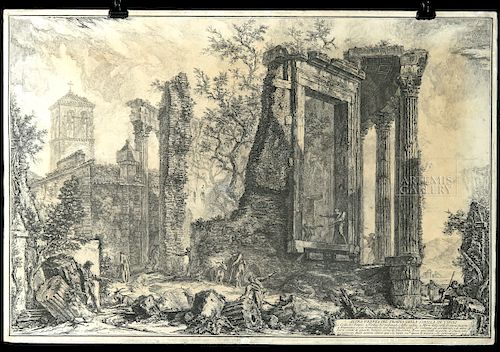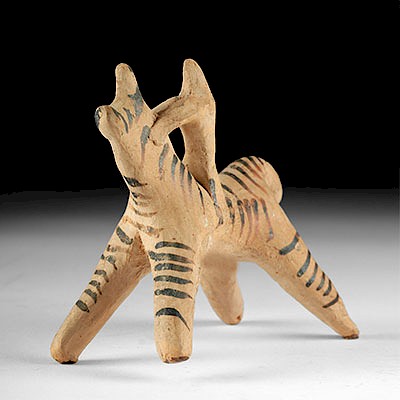18th C Piranesi Etching - Temple of the Sibyl at Tivoli
Lot 183
About Seller
Artemis Fine Arts
686 S Taylor Ave, Ste 106
Louisville, CO 80027
United States
Selling antiquities, ancient and ethnographic art online since 1993, Artemis Gallery specializes in Classical Antiquities (Egyptian, Greek, Roman, Near Eastern), Asian, Pre-Columbian, African / Tribal / Oceanographic art. Our extensive inventory includes pottery, stone, metal, wood, glass and textil...Read more
Estimate:
$1,200 - $1,800
Absentee vs Live bid
Two ways to bid:
- Leave a max absentee bid and the platform will bid on your behalf up to your maximum bid during the live auction.
- Bid live during the auction and your bids will be submitted real-time to the auctioneer.
Bid Increments
| Price | Bid Increment |
|---|---|
| $0 | $25 |
| $300 | $50 |
| $1,000 | $100 |
| $2,000 | $250 |
| $5,000 | $500 |
| $10,000 | $1,000 |
| $20,000 | $2,500 |
| $50,000 | $5,000 |
| $100,000 | $10,000 |
| $200,000 | $20,000 |
About Auction
By Artemis Fine Arts
Oct 25, 2018
Set Reminder
2018-10-25 11:00:00
2018-10-25 11:00:00
America/New_York
Bidsquare
Bidsquare : Antiquities from Egypt, Greece, Italy, Asia
https://www.bidsquare.com/auctions/artemis-gallery/antiquities-from-egypt-greece-italy-asia-3538
Featuring Egyptian, Greek, Roman, Etruscan, Near Eastern, plus Asian art from Central and Far East. If you love the classics, this is the sale for you. Artemis Fine Arts info@artemisgallery.com
Featuring Egyptian, Greek, Roman, Etruscan, Near Eastern, plus Asian art from Central and Far East. If you love the classics, this is the sale for you. Artemis Fine Arts info@artemisgallery.com
- Lot Description
Francesco Piranesi (Italian, Rome 1756-1810 Paris) after Giovanni Battista Piranesi (Italian, Mogliano Veneto 1720–1778 Rome). Altra Veduta Del Tempio Della Sibilla in Tivoli. (Another view of the Temple of the Sibyl at Tivoli) - the broken side of the Colonnade. Engraving from Vedute di Roma (Views of Rome). Originally issued in 1749-50. Reissued in 1761. Continued by Giovanni Battista Piranesi's son Francesco in Paris, France later in the 18th century where he lived during the Revolution. A passionate admirer of Classical architecture, Giovanni Piranesi actually considered himself an architect. Indeed his drawings and etchings demonstrate his dramatic penchant for manipulating perspective and architectural elements - resulting in creative imaginings of ancient buildings, prisons, and ruins. Such fantastical compositions made sense coming from the man who once declared, "I need to produce great ideas, and I believe that if I were commissioned to design a new universe, I would be mad enough to undertake it." Size: 18.25" L x 26.25" W (46.4 cm x 66.7 cm)
Francesco Piranesi was also an Italian engraver, etcher, and architect and continued his father's series of engravings of ancient temples and monuments in France, where he resided for a long time during the French Revolution. Born in Venice on the 4th October 1720, the son of a stonemason and master builder, Giovanni Battista Piranesi would become a pioneer of the Neoclassical movement in the late 18th century as a master printmaker and antiquarian. Piranesi trained as an architect under his uncle Matto Lucchesi and Carlo Zucchi, and in 1740, left Venice for Rome where he studied etching with Giuseppe Vasi. While he had limited success winning architectural commissions, his training and passion for classical architecture served him well. Engravings and etchings provided Piranesi with a healthy livelihood, allowing him to turn one of his favorite pastimes, drawing Roman architecture, into a lucrative source of income. By 1747, Piranesi had begun the work for which he is best known, the Vedute di Roma (Views of Rome) and created plates for the series until his death in 1778. He created thousands of works that recorded the Roman monuments as well as those of the Renaissance which were impressive for not only their documentary value but also their immense artistry.
Provenance: private East Coast, USA collection
All items legal to buy/sell under U.S. Statute covering cultural patrimony Code 2600, CHAPTER 14, and are guaranteed to be as described or your money back.
A Certificate of Authenticity will accompany all winning bids.
We ship worldwide and handle all shipping in-house for your convenience.
#139779Normal age wear. Professionally repaired and backed.Condition
- Shipping Info
-
All shipping is handled in-house for your convenience. Your invoice from Artemis Gallery will include shipping calculation instructions. If in doubt, please inquire BEFORE bidding for estimated shipping costs for individual items.
-
- Buyer's Premium



 EUR
EUR CAD
CAD AUD
AUD GBP
GBP MXN
MXN HKD
HKD CNY
CNY MYR
MYR SEK
SEK SGD
SGD CHF
CHF THB
THB















